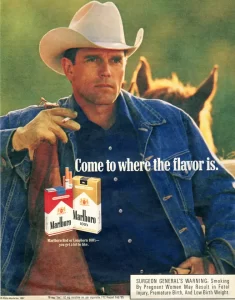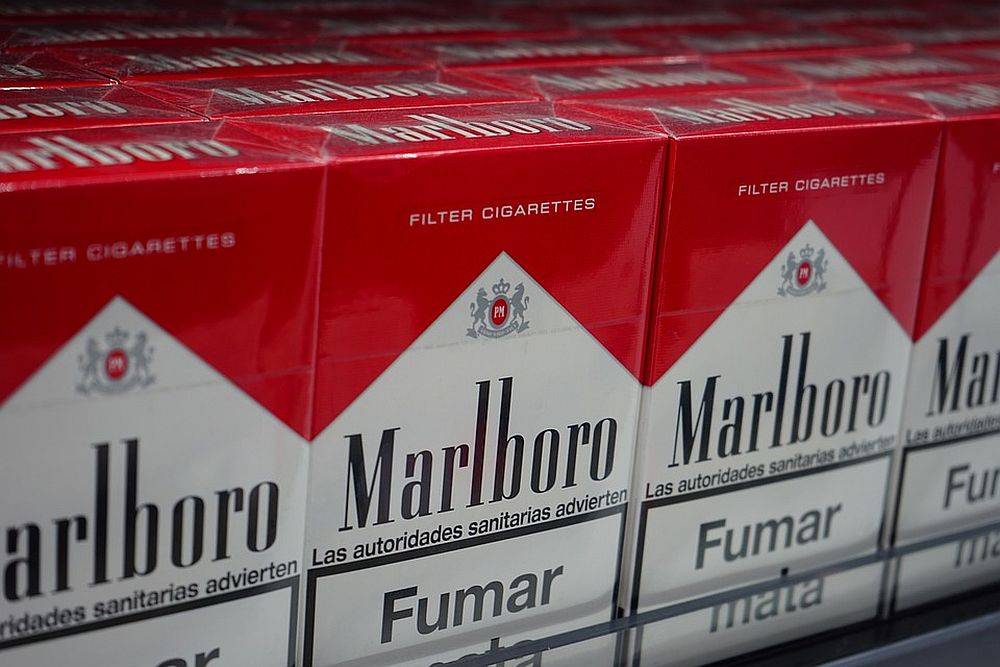Marlboro is a brand of cigarette famous for its flavor, billboard advertisements and magazine advertisements of the Marlboro Man. By 1992, Financial World ranked Marlboro the world’s No. 1 most valuable brand, with a market worth of $32 billion. In 2001 it was the most popular cigarette brand in the U.S.
Marlboro smoker, now personified by the rugged cowboys who puff on cigarettes was once meant for
woman. Marlboro Brand was born in 1924 as one of the first women’s cigarettes. During that time, the idea of marketing cigarettes to women was a taboo. Advertisers had to address the issue of stained teeth, foul breath, and addictive cravings, not to mention that dry, heaving morning cough. Philip Morris decided that their brand needed to have a classy, sophisticated name. Winston Churchill was in the news at the time, and it was being reported that he was related to the Earl of Marlborough.
Philip Morris marketers liked the sound of the Marlborough name, but didn’t think it looked good on the pack. They lopped off the “ugh” and came up with Marlboro. In the 1920s, the Marlboro campaign was based on how the cigarette was different. They painted a red band around the filter to hide those unattractive lipstick stains, calling them “Beauty Tips to Keep the Paper from Your Lips.” They called Marlboro the “Mild as May” cigarette for women and added a tag line -“Discerning feminine taste is now confirming the judgment of masculine connoisseurs in expressing unanimous preference for the Aristocrat of Cigarettes. . . .” The brand had a small share to survive. After Two decades, Philip Morris decided to “reposition” the brand due to low volume of sales.
Problem with “Women’s Cigarette Brands”
In the early 1950s, scientists published a major, well publicized study linking smoking to lung cancer. This publication had a great publicity impact. In 1953, for the first time, cigarette consumption slowed in the United States. During the same era Reader’s Digest magazine published a series of articles that linked smoking with lung cancer.
The cigarette companies moved fast. They pursued an offensive strategy: claiming that the studies were
“inconclusive” on cigarette safety while implying that their brands were “safer” than those other, more dangerous, brands. The brands that were lost their market share were nonfilter brands.
Filter cigarettes were perceived by smokers as safer, but up to that point of time filter cigarettes had been marketed to only women. Many men now wanted a filtered brand, thinking that it will be safer, but were afraid that smoking women’ brand in public will show them in poor light, if they switched to a woman’s brand.
Cigarette manufacturers are not in favour of filter cigarettes to men, as it may perceived to reinforce the
image that cigarettes induce the bad effects of cigarettes, filters implied that smoke was unpleasant or dangerous.
The Marlboro Man Repositioning
However, they are driven by profits. Filtered cigarettes were more profitable because the filter material was cheaper than a comparable amount of tobacco. Besides, filters screened out some of the smoke’s harshness, which meant they could get by with a cheaper grade of tobacco.
Philip Morris decided to give Marlboro repositioning. The company hired Chicago advertising executive Leo Burnett to design the strategy. Burnett created advertising characters like the Jolly Green Giant, the Keebler Elves, and the lonely Maytag Repairman, Charlie the Tuna, Poppin’ Fresh, and Morris the Cat.
When he thought about repositioning Marlboros, he decided to use a series of the manliest images he could think of. He intended to present a series of ship captains, weight lifters, adventurers, war correspondents, construction workers, Marines, and the like. The cowboy was his first image of the series. Philip Morris had his reservations. It hired a research company. The research agency reported that there were only three thousand cowboys in the entire United States at that time. The research report said the men in town will not identify with cowboys. Burnett convinced the company to try the cowboy image.

Result of the campaign
The campaign worked. In one year, Marlboro brand share increased from marginal presence, to the fourth bestselling brand.
Just know that in 1955 Marlboro recorded sales of 5 billion dollars. By 1957, that $5 billion had become $20 billion— a 300% increase.
Burnett’s first set of cowboys were professional models, some of whom had never been on a horse before. That led to a series of embarrassing problems. For example, an early advertisement showed a cowboy’s legs in close-up: His blue jeans were well-worn, his hand-tooled boots were scuffed in all the right places, but his spurs were upside-down. After that, the agency started recruiting real cowboys from places like Texas and Montana for their ads.
In 1955, the agency added a trademark tattoo to their cow boy’s hand. One model observed after a photo shoot that they had spent three minutes making up his face-and three hours painting the tattoo. In 1962, Burnett’s agency bought the rights to The Magnificent Seven theme and added words to it for their TV ads (“Come to where the flavor is . . . Come to Marlboro Country”).
Since then, the Marlboro Man has been among the most successful campaigns ever, keeping the cigarette at or near the top of mind recall for years. When cigarette ads were banned in 1971, the cowboy made a smooth transition to print and billboards since he never said anything anyway. He continued squinting off into the distance with that self absorbed expression. Everyone seems to love the cowboy.
In France, Philip Morris sued an antismoking group that used a cowboy model to deliver an antismoking message, claiming trademark infringement. Philip Morris won a small victory-a judgment of 1 franc instead of the $3 million he asked for, However the advertisements were off the print.
More success at Collaborations
Marlboro thrived on the back of this success and began to employ authentic ranchers for the shoots, increasing the credibility of the campaign with the mass populous. This credibility allowed the company to branch into Motorsports (even if you don’t like F1, you’re likely aware of the presence Marlboro has in the sport) and even dipping into Fashion here and there, with pieces from the 20th century still revered on Depop, eBay, and the like.
And some Cowboy Embarrassment as well..
The real cowboy models, meanwhile, have periodically embarrassed the company by dying from smoking-related diseases like lung cancer, emphysema, and strokes.
David McLean, who appeared in many Marlboro television and print advertisements starting in the early 1960s, also died of cancer at age 73 on 12 October 1995. McLean starred in the short-lived 1960 television Western Tate, and he played roles in numerous television series and feature films during the 1960s and 1970s. McLean took up smoking at age 12, began to suffer from emphysema in 1985, and had a cancerous tumor removed from his right lung in 1993. Despite the surgery, the cancer remained and spread to his brain and spine, and McLean succumbed in 1995. In August 1996 McLean’s widow and son filed a wrongful death lawsuit against Philip Morris, Inc., claiming that McLean was unable to stop smoking because of his nicotine addiction, and that his smoking habit was the cause of his lung cancer.
The lawsuit contended, among other issues, that McLean had been obligated to smoke up to five packs per take in order to get the right look while posing for advertisements, and that he received cartons of Marlboro cigarettes as gifts from Philip Morris.
Also Read: Case Study | Dunkin’ Donuts Rebrands to Dunkin’
To read more content like this, subscribe to our newsletter
Go to the full page to view and submit the form.

